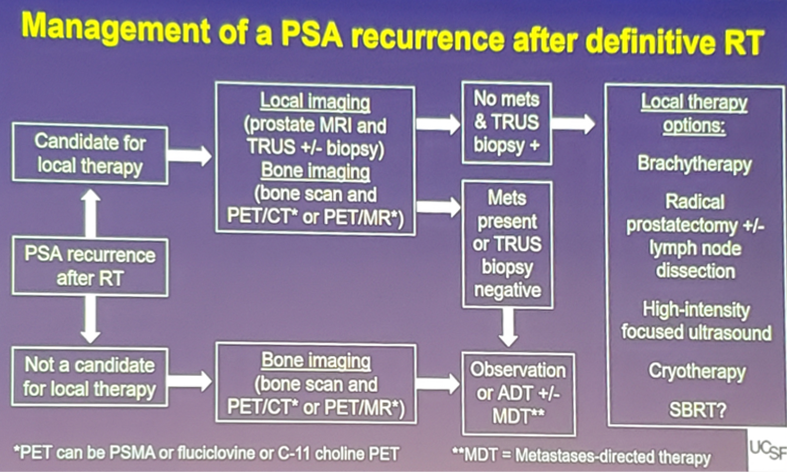Basel, Switzerland (UroToday.com) Dr. Felix Feng from UCSF presented during the PSA Recurrence after Radical Local Therapy and Oligometastatic Prostate Cancer session at the Advanced Prostate Cancer Consensus Conference (APCCC) 2019 by discussing the management of men with PSA recurrence after radical local radiation therapy. Dr. Feng notes that over 1.2 million patients worldwide are diagnosed with prostate cancer each year, and in the United States over one-third of patients with localized prostate cancer are treated with radiation therapy. Depending on the disease characteristics, 15-70% of prostate cancer patients recur after definitive radiation therapy, thus these figures suggest that over 100,000 men may present with recurrent disease after upfront radiation therapy.
PSA recurrence after radiation therapy is defined in several ways. The RTOG-ASTRO Phoenix Consensus Definition is a PSA increase by 2 ng/mL or more after the PSA nadir, however, many clinicians do not wait for the Phoenix criteria to be achieved before evaluating recurrence. The NCCN guidelines suggest that a recurrence evaluation should be considered when PSA has been confirmed to be increasing after radiation even if the increase above nadir is not yet at 2 ng/mL, especially in candidates for salvage local therapy who are young and healthy.
According to Dr. Feng, the management of a PSA recurrence after definitive radiation therapy includes the initial workup (imaging with a potential biopsy), local therapy for local recurrences, local therapy for regional or distant recurrences, and systemic therapy. For this particular talk, Dr. Feng highlights that he will focus on the workup and treatment of local recurrences.
The significance of a local recurrence after radiation therapy was recently evaluated by the MSKCC group and published in the Journal of Urology.1 In this study, 382 patients underwent a posttreatment biopsy after external beam radiotherapy for clinically localized prostate cancer. The prevalence of positive biopsy was 30%, the treatment effect was 22%, and a negative biopsy was 48%. Importantly, the 15-year PSA relapse rate associated with a negative biopsy was 34%, the treatment effect was 36%, and positive posttreatment biopsy was 79%. The risk of distant metastasis was 2.6-fold higher in patients with a positive biopsy and cause-specific mortality was twice as high in patients with a positive biopsy compared to those with negative biopsy/ treatment effect biopsy.
In Dr. Feng’s personal criteria for who is an ideal candidate for local therapy after radiation therapy failure are as follows:
- Original clinical stage T1-2, NX or N0
- Life expectancy >10 years
- PSA now <10 ng/mL
- Long interval to recurrence (> 3 years)
- Long PSA doubling time (>12 months)
- Organ-confined at recurrence (assessed by ie. MRI)
It is important to assess these patients with both local and bone imaging. Advanced imaging has changed our ability to detect disease at low PSA levels. The recent single-arm multi-center trial by Fendler et al.2 assessed the accuracy of 68Ga-PSMA-11 PET in localizing recurrent prostate cancer among 635 patients with biochemically recurrent prostate cancer after prostatectomy (n = 262, 41%), radiation therapy (n = 169, 27%), or both (n = 204, 32%).2 68Ga-PSMA-11 PET localized recurrent prostate cancer in 475 of 635 (75%) patients, and detection rates significantly increased with PSA (p<0.001):
- 38% for <0.5 ng/mL (n = 136)
- 57% for 0.5 to <1.0 ng/mL (n = 79)
- 84% for 1.0 to <2.0 ng/mL (n = 89)
- 86% for 2.0 to <5.0 ng/mL (n = 158)
- 97% for ≥5.0 ng/mL (n = 173)
Furthermore, 15-30% of patients in this setting of isolated local failures. Disease recurrence patterns outside of the prostate are typically localized to the iliac nodal chain (most common) and retroperitoneal nodes.
In summary of the above, Dr. Feng highlighted his management of a PSA recurrence after definitive radiation therapy with the following algorithm:

According to Dr. Feng, there is a “potpourri of options” for local therapy in this setting, including brachytherapy, salvage radical prostatectomy, HIFU, cryotherapy, and SBRT. He notes that almost all of the salvage therapies for post-radiation therapy local recurrence are retrospective in nature.
Dr. Feng concludes this presentation with the following take-home messages:
- There is a significant subset of prostate cancer patients with PSA recurrence after definitive radiation therapy
- Positive posttreatment biopsies are associated with metastatic progression
- Advanced imaging approaches allows detection of recurrences at PSA levels lower than the nadir +2 (Phoenix criteria) definition
- Treatment approaches for biopsy-proven local recurrences (in the absence of metastases) include salvage brachytherapy, radical prostatectomy, HIFU and cryotherapy
Presented by: Felix Y. Feng, MD, Associate Professor of Radiation Oncology; Urology; and Medicine, Vice Chair for Faculty Development and Director of Translational Research, Department of Radiation Oncology University of California, San Francisco, California
Written by: Zachary Klaassen, MD, MSc – Assistant Professor of Urology, Georgia Cancer Center, Augusta University/Medical College of Georgia Twitter: @zklaassen_md at the 2019 Advanced Prostate Cancer Consensus Conference (APCCC) #APCCC19, Aug 29 – 31, 2019 in Basel, Switzerland
References:
- Zelefsky MJ, Goldman DA, Reuter V, et al. Long-term Implications of a Positive Posttreatment Biopsy in Patients Treated with External Beam Radiotherapy for Clinically Localized Prostate Cancer. J Urol 2019 Jun;201(6):1127-1133.
- Fendler WP, Calais J, Eiber M, et al. Assessment of 68Ga-PSMA-11 PET Accuracy in Localizing Recurrent Prostate Cancer: A Prospective Single-Arm Clinical Trial. JAMA Oncol 2019 Jun 1;5(6):856-863.
